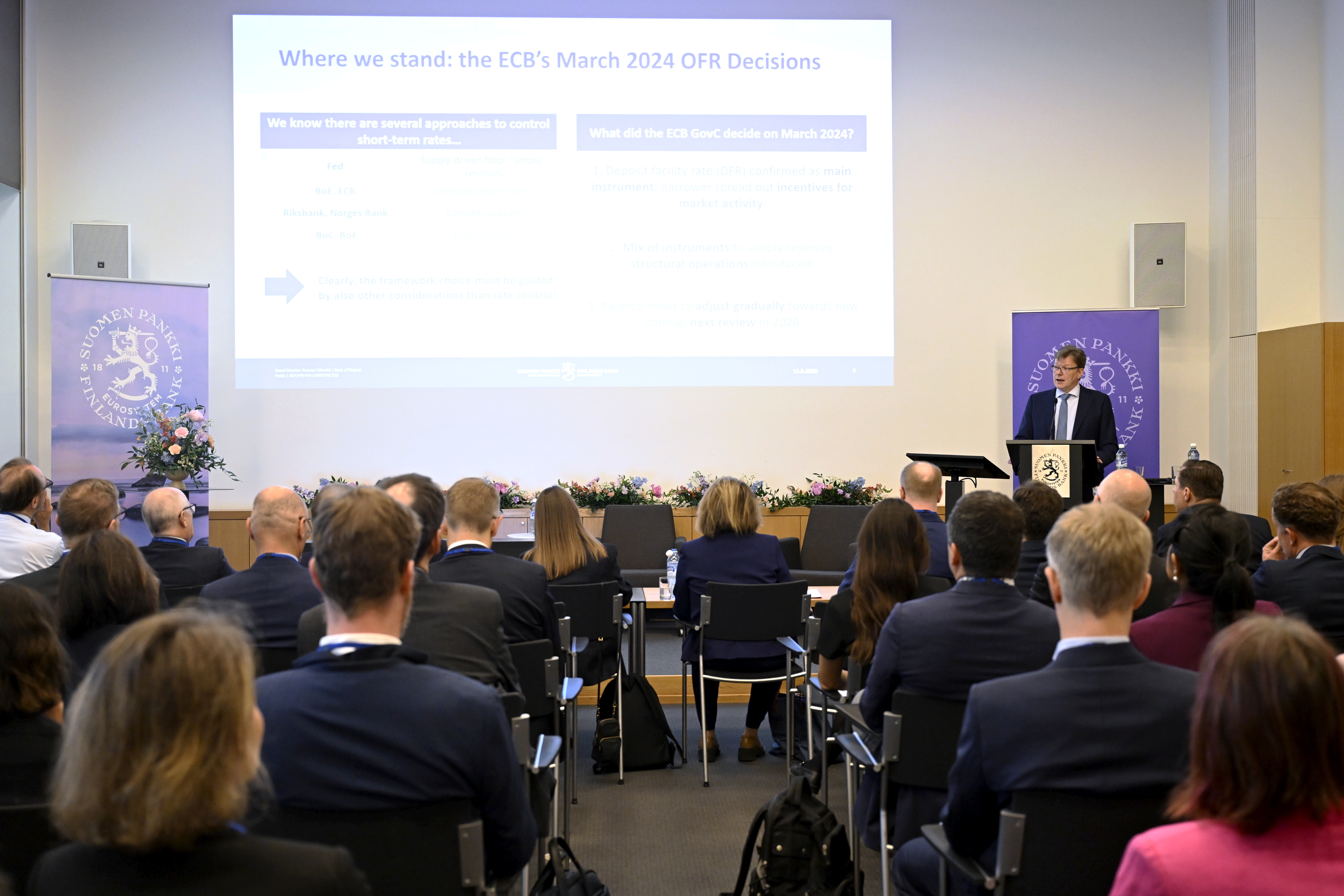Blog
Old wisdom and new trends in monetary policy implementation

Board Member Tuomas Välimäki delivering his keynote at the Bank of Finland & SUERF Conference "Monetary Policy Implementation: Old Wisdoms and New Trends" in Helsinki on 11 June 2025.
On 11 June, the Bank of Finland and SUERFSUERF - The European Money and Finance Forum. organized a conference on the evolving landscape of monetary policy implementation in Helsinki. The event provided a unique opportunity to reflect on the global shift towards a new phase in monetary policy implementationMonetary policy implementation comprises the tools, instruments and procedures used by central banks to implement monetary policy decisions i.e. typically steering short-term market interest rates. The tools and instruments also affect the size and composition of the central bank’s balance sheet. For more information see ECB: What is the operational framework and what does it do?.. Participants revisited established principles while also brainstorming on new innovative ideas to address new trends emerging in financial markets and their infrastructure.
This was not an academic conference, but rather a high-level forum that brought together senior policymakers, practitioners and market participants in the field. The conference featured a broad geographical representation, with insights from the Euro area, Sweden, the United States, the United Kingdom, Canada, and international organizations like the IMF and BIS.
From corridors to floors
The discussions covered the size and role of central bank balance sheet, the design of central bank liquidity tools, and the role of the market for central bank reserves.
After years of unconventional monetary policy measures—such as quantitative easing, which led to expanded balance sheets and abundant reserves—central banks are transitioning towards a “new normal”. As a result, many have embarked on reforms of their monetary policy implementation frameworks, which now look very different compared to those in place before the Great Financial Crisis (GFC).
Gone are the days of scarce reserves and only a few central banks have opted to return to the corridor system, where short-term money market rates are steered towards the midpoint of an interest rate corridor established by standing facilities for overnight central bank deposits and lending.
Instead, most western central banks have decided to stay in floor systems where rates are steered with the remuneration rate on central bank reserves or the overnight deposit facility rate.
However, a key takeaway from the conference was that there is no universally optimal way to decide on the framework. Rather each central bank must tailor its framework to its financial market structure and institutional setup, balancing the associated tradeoff between market footprint and monetary control. The choice depends also on the central bank’s own preferences.
Uncertainty requires flexibility
In many cases the new operational frameworks have not yet been tested in practice as balance sheet normalization is still under way. After the “new normal” has set in, the robustness of the frameworks will be eventually tested in future crises. Consequently, flexibility, robustness and readiness to adapt featured heavily in the presentations and ensuing discussions.
Uncertainties relate to the demand for central bank reserves by banks for precautionary, settlement or regulatory purposes and the functioning of the market for those central bank reserves. During the transition away from abundant central bank reserves and drawing on the lessons of the past episodes of financial market turbulence, many frameworks have now built-in features that allow for automatic adjustment to changes in banks’ central bank reserve demand or enable central banks to swiftly modify operational parameters.
Beyond the core decision of whether to adopt a corridor, floor or hybrid framework, there are other consequential decisions that determine how central banks interact with the new landscape of financial markets, payments technology and regulation. These relate to the accepted collateral for central bank borrowing, the opportunity cost and method for providing central bank reserves and the means to fulfill the structural liquidity deficit resulting from banknotes, government deposits and, in some cases, minimum reserve requirements.
Work continues
Central banks will continue to carefully monitor the transition to new frameworks, the demand for central bank reserves, the use of central bank tools and instruments and overall market functioning. One often-mentioned concern was the possible issue of stigma related to borrowing from the central bank. Stigma poses a risk to central banks’ ability to steer rates. To mitigate this, central banks are proactively addressing stigma with both thoughtful communication and the appropriate design of their lending operations.
In line with the ECB Governing Council statement in March 2024The ECB Governing Council decided to continue to steer monetary policy stance by adjusting deposit facility rate (DFR), provide liquidity through broad mix of instruments, conduct main refinancing operations (MROs) through fixed-rate tenders with full allotment against broad collateral and narrow the spread between the rate on MROs and DFR to 15 basis points. Furthermore, the Governing Council decided to introduce new structural longer-term refinancing operations and a structural portfolio of securities at a later stage., the ECB will review its operational framework by 2026. This conference was an important contribution to that review and to the broader understanding of how central banks can implement policy effectively in different environments.



